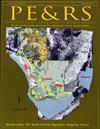FABDEM在表示裸地高度方面优于Global dem
IF 2
4区 地球科学
Q4 GEOGRAPHY, PHYSICAL
引用次数: 0
摘要
许多遥感和地球科学应用需要高精度的地形模型。2022年,森林和建筑物移除哥白尼数字高程模型(FABDEM)发布,其中树木和建筑物以30米的分辨率被移除。因此,有必要对该模型进行综合评价。本研究的目的是进行定性和定量分析的fabdem与常用的全球dem的比较。我们研究了地形坡度、坡向、粗糙度和土地覆盖类型对所有dem地形表示误差的影响。该装置的整体垂直精度最高,为5.56米。该模型最能反映地形的粗糙度。与其他模型相比,fabdem和哥白尼dem受坡度的影响同样大,坡度表示精度最差。在植被区、建成区和淹没区,平均高程误差分别降低了约3.34 m、1.26 m和1.55 m。根据Welch’st检验,fabdem和哥白尼dem高度之间没有显著差异。然而,fabdem的轻微改进使其成为代表不同土地覆盖类型的地形高度的最佳过滤dem。本文章由计算机程序翻译,如有差异,请以英文原文为准。
The FABDEM Outperforms the Global DEMs in Representing Bare Terrain Heights
Many remote sensing and geoscience applications require a high-precision terrain model. In 2022, the Forest And Buildings removed Copernicus digital elevation model (FABDEM) was released, in which trees and buildings were removed at a 30 m resolution. Therefore, it was necessary to make a comprehensive evaluation of this model. This research aims to perform a qualitative and quantitative analysis of fabdem in comparison with the commonly used global dems. We investigated the effect of the terrain slope, aspect, roughness, and land cover types in causing errors in the topographic representation of all dems. The fabdem had the highest overall vertical accuracy of 5.56 m. It was the best dem in representing the terrain roughness. The fabdem and Copernicus dem were equally influenced by the slopes more than the other models and had the worst accuracy of slope representation. In the tree, built, and flooded vegetation areas of the fabdem, the mean errors in elevation have been reduced by approximately 3.34 m, 1.26 m and 1.55 m, respectively. Based on Welch's t-test, there was no significant difference between fabdem and Copernicus dem elevations. However, the slight improvements in the fabdem make it the best filtered dem to represent the terrain heights over different land cover types.
求助全文
通过发布文献求助,成功后即可免费获取论文全文。
去求助
来源期刊

Photogrammetric Engineering and Remote Sensing
地学-成像科学与照相技术
CiteScore
1.70
自引率
15.40%
发文量
89
审稿时长
9 months
期刊介绍:
Photogrammetric Engineering & Remote Sensing commonly referred to as PE&RS, is the official journal of imaging and geospatial information science and technology. Included in the journal on a regular basis are highlight articles such as the popular columns “Grids & Datums” and “Mapping Matters” and peer reviewed technical papers.
We publish thousands of documents, reports, codes, and informational articles in and about the industries relating to Geospatial Sciences, Remote Sensing, Photogrammetry and other imaging sciences.
 求助内容:
求助内容: 应助结果提醒方式:
应助结果提醒方式:


